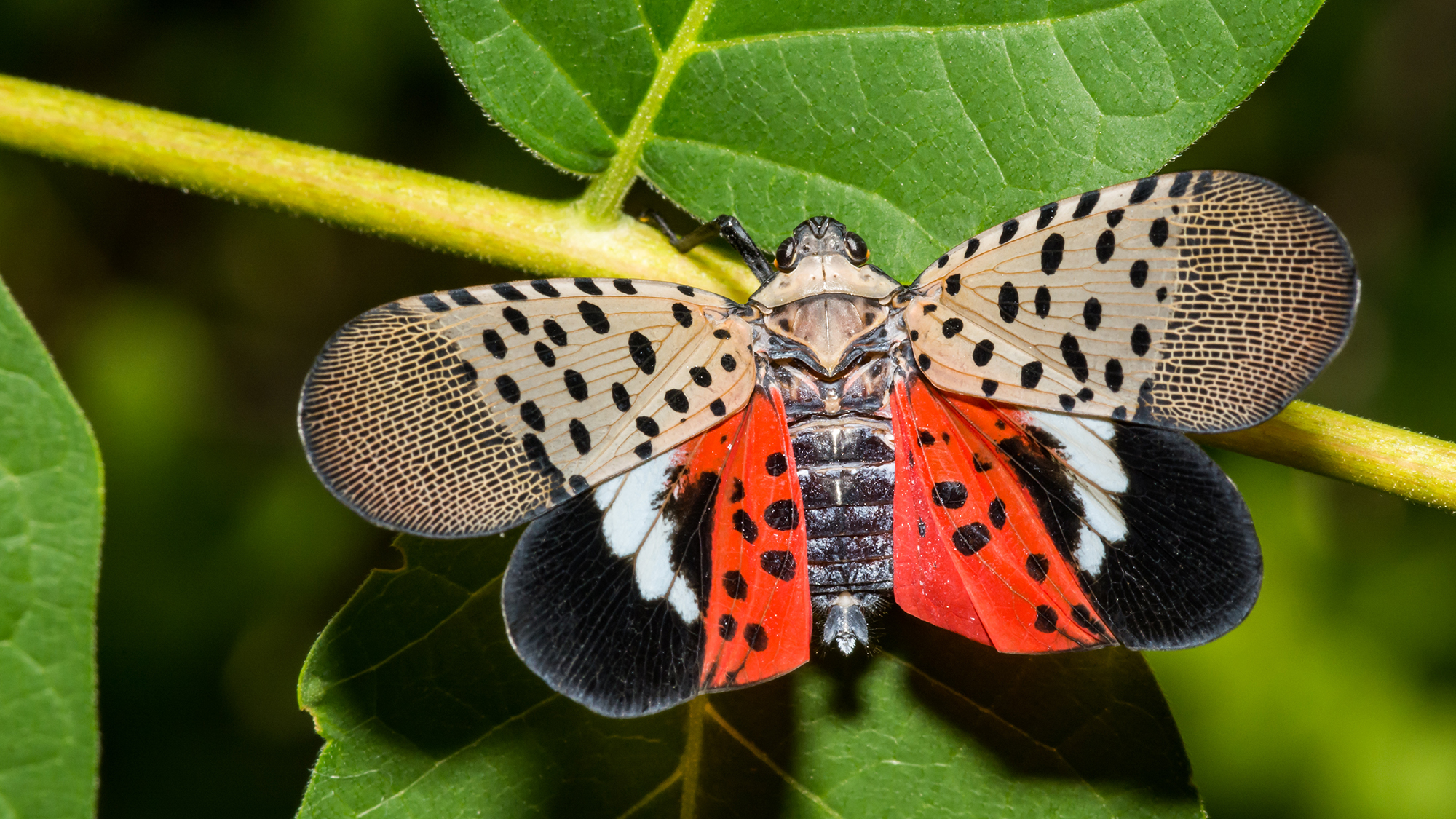
A decade into an insect invasion, there’s some hope on the horizon. DepositPhotos
If you live anywhere from central Virginia to southern New England, you’ve probably witnessed the hordes up close: Massive numbers of polka-dotted pests clustered on vines, branches, and buildings. They start showing up in the springtime as black and white nymphs raining down from the canopy. Then, they go through months of growth stages, becoming bigger and more proficient at distance jumping with each molt. Finally, they transform into the flashy, red, white, black, and beige winged adults coating tree trunks and splattering sidewalks by late summer.
The spotted lanternfly’s (Lycorma delicatula) exact native range is debated, but scientific records agree that the species originated in China. The insects were initially detected in the U.S. in 2014 in southeastern Pennsylvania. Ten years on, they’ve multiplied into a widespread, headline-making, invasive, and costly agricultural pest, particularly for grape growers and vineyards. With their piercing, sucking mouthparts, lanternflies feed on many different plants, and can stress and kill certain species, as they swarm their preferred host plants. Infestations have now been confirmed in 17 states along the East Coast and into the Midwest and Southeast.
They don’t sting, bite, or spread human disease. Yet even if you’re not a grape farmer, the sheer amount of spotted lanternflies popping up in regional infestations can become an unsettling nuisance. And if you live in an area where populations are on the rise, you might be wondering what the future holds. Will every surface eventually be covered in lanternflies? Is there any hope? What are we doing to stop it?
Thankfully, experts closely studying lanternflies have insights to offer, and there are some encouraging signs emerging. Scientists haven’t given up on exploring better ways to manage them. So far, there’s been little evidence that the bothersome insects pose an ecological threat. And lanternfly numbers have waned in the Pennsylvania counties where they first showed up a decade ago.
But first, here’s the bad news: We’re almost certainly not going to eradicate spotted lanternflies from the U.S.. “We’re far beyond that now,” says Brian Walsh, a horticulture educator and spotted lanternfly researcher at the Pennsylvania State University’s extension program. With such an established invasive, “eradication is not generally the goal,” agrees Hannah Broadley, an entomologist and biological scientist at the U.S. Department of Agriculture’s Plant Health Inspection Service.
Instead, active management is focused on preventing further spread through state quarantine and surveillance programs. And researchers are working to find better ways to keep populations in check where the insect is already present. The hope is to “hit the threshold where it’s not at pest-status anymore,” says Broadley.
Biological controls in the works
Currently, pesticides and physical traps are the only proven ways to locally manage the insects. But both traps and poisons have their downsides. Sticky traps can ensnare native wildlife and insecticides can cause environmental harm. Plus, lanternflies are likely to eventually evolve resistance to current methods, triggering an expensive chemical arms race, says Kelli Hoover, an entomology professor at Penn State.
In lieu, the ideal method for minimizing lanternfly populations long-term would be biological control–the use of natural predators and enemies to kill off the planthoppers, Hoover says. Through research, appropriate biocontrols are drawing ever-nearer. Broadley is currently investigating a parasitoid wasp as a potential solution. Dryinus sinicus is a tiny speck of an insect also native to China, where it injects its eggs into lanternfly nymphs–killing them as part of its reproductive cycle.
For months now, Broadley and her USDA colleagues have been running tests to see if Dryinus will stay focused on lanternflies, given the choice of other hosts. It’s important to ensure biological control agents don’t backfire, and hurt native species–as has happened before in notorious, botched releases. “It’s still very much early days, but so far [Dryinus sinicus] looks good,” she says.
And it’s not just the one parasitoid wasp hungry for lanternfly flesh. Other research has found that a couple of North American fungi species attack and kill the pest. And some native animal species are also starting to develop a taste for the invaders. So far, neither of these things have proven enough to lower lanternfly populations, but that could soon change, with a little human intervention.
Hoover is researching natural predation of lanternflies. In one recent study, she published community science observations of many different animals chowing down on the bugs (scientifically, they are “true bugs”). Lanternflies can sequester toxins from the tree of heaven, one of their preferred hosts and another widely invasive species in the U.S., and become toxic themselves. But birds, some mammals, and even occasionally amphibians and fish seem to be eating lanternflies anyway. Far and away though, the most prolific predators of the lanternflies are other creepy crawlies. Over half of all recorded instances of predation in Hoover’s study were arthropod-on-arthropod incidents. Moreover, Hoover says predatory insects and spiders are “totally unaffected” by the chemicals lanternflies can horde, according to forthcoming research from her lab.
Specifically, insects like praying mantises and spined soldier bugs have been shown to reduce lanternfly numbers pretty quickly in enclosures. Currently, Hoover is investigating if the spined soldier bugs will prefer lanternflies over other prey, given other choices. If they do, then the predatory stink bugs could be another biocontrol in the toolkit. So far, “we think these are pretty promising,” she says. The additional good news is that spined soldier bugs are already used as a biological control for other pests, making them widely reared and available. Perhaps grape growers and state agencies could begin targeted releases to bolster the native bugs’ numbers in regions hit hardest by lanternflies, Hoover suggests.
There’s historical precedent for both natural enemies and introduced biological controls getting the job done. Broadley references the case of winter moth, an invasive imported from Europe that can decimate forests. The introduction of a parasitoid fly has proven successful in reducing the pest’s populations in New England. Walsh notes that the Japanese Beetle, too, has been reigned in, in part by multiple predator and parasitoid introductions.
Brown marmorated stink bugs, another invasive that first appeared in Pennsylvania, were once a similar scourge in the mid-Atlantic. Their massive numbers around 2010 made them a household and agricultural pest. But a suite of biological controls, including native predators and an accidentally introduced parasitoid wasp, has brought them down to a manageable population in the region, says Hoover.
Cautious optimism
Even if none of the prospective lanternfly biocontrols pan out in the immediate, there is still some good news. Ten years of research has yet to indicate that spotted lanternflies pose a serious threat to any native species, says Walsh. Beyond their voracious appetites for a handful of hosts, lanternflies’ diet of plant juice does lead the planthoppers to produce ample sugary honeydew, which can coat leaves, causing unsightly sooty mold to grow and locally limiting photosynthesis. Yet even this has seemed to be relatively harmless on the larger scale.
“A decade is a short time in terms of an ecosystem,” he adds, “so we have to be very cautious.” After all, problems may emerge over the longer term, or if the insect spreads to new, vulnerable locations. But for now, it’s a tentative “no” to the question of if lanternflies are destabilizing the habitats they invade. “We just haven’t experienced it yet,” he says. Hoover agrees. She chalks up lanternflies’ lack of reverberating ecosystem impacts to their affinity for tree of heaven. As with grapes, lanternfly swarms can kill the invasive plant–but the tree of heaven is a pest in its own right and nothing native depends on it.
Then, there’s the data from the first Pennsylvania counties to contend with lanternflies. “We’ve actually seen a pretty dramatic [population] decline in the area where it first started and in cities where it first got bad, like Philadelphia,” says Walsh. “The numbers have been dropping significantly. We generally see a three, four, or five year build-up– then it drops off.”
Why isn’t clear, though there are hypotheses, he says. It might be that their preferred food resources have dried up over time. It might be that native predators are picking up more slack than individual studies have shown. It could be that the insects have simply spread out and moved. Or other population dynamics factors might be at play. “It’s all guesses at this point. We’re not sure, but it’s probably a mix of all of those.”
They could come back, notes Hoover, and sometimes they seem to as host plants rebound–but take heart that their populations cannot and don’t increase indefinitely. Like everything in nature, there is a limit.
A history of other invasive insects indicates many species settle into boom and bust cycles. For example, spongy moths may be virtually absent for years on end before appearing en masse and defoliating forests. “If I had a crystal ball, I would say that’s probably what we’re going to start seeing with lanternflies after the peak drops out,” says Walsh. “We might see some resurgences from year to year, but probably it will never approach anything like it was at its worst. Probably.”
Achieving balance
Still though, active management is key to prevent further spread and mitigate harm where invasions have already begun, says Walsh. California, Oregon, and Washington–all states with major wine regions–have begun proactively preparing for the possibility of invasion, notes Hoover. West Coast researchers are testing possible biocontrols on their own native species and investigating other management tactics.
Seven states have instituted quarantine programs to limit cross-border transportation of lanternfly eggs and live insects. If you live in a quarantine zone, you too have a legally mandated responsibility to avoid transporting lanternflies elsewhere. Check for the rules and regulations in your area.
Finally, a big part of balance is accepting and understanding that, applied carelessly, “solutions” can prove worse than problems. Walsh urges residents grappling with lanternflies in their own gardens and backyards to approach their invaders thoughtfully. Smashing and squishing is always encouraged, but “be cognizant that when you use pesticides, there are going to be other downsides,” he says. In some cases, targeted insecticide applications and traps can be a good call. In other instances, they’re likely not necessary. In either scenario, education is key. PennState Extension offers a comprehensive management guide to help people decide if, when, how, and what they should spray or set-up at home.
“Make good choices,” says Walsh and don’t forget that patience is an option. “In areas where it seems like a biblical plague, things are likely going to mellow out. You don’t have to kill every single one yourself.”
>>> Read full article>>>
Copyright for syndicated content belongs to the linked Source : Popular Science – https://www.popsci.com/environment/spotted-lanternfly-update/































